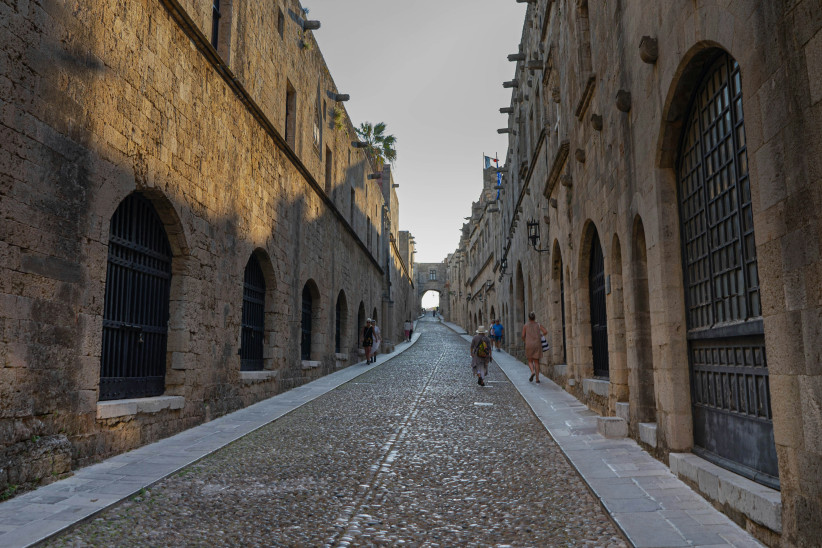The city of Rhodes was founded in 408 BC. at the northernmost point of the island and was built based on an even urban planning system, designed by Hippodamus
By Nikolas Bardis
Rhodes is by common confession one of the most beautiful and special cities of our country, with a great history, special monuments and natural beauty. Today there are 54,562 inhabitants and the city remains alive even in the winter months. The Kastelo and the Mandraki with the famous deer, symbols of the island, give a distinct identity to the city, which can and does combine the old with the modern in an exemplary way. It is no coincidence that it is one of the most popular tourist destinations at European level, with millions of tourists visiting it from all over the world and declaring themselves fascinated by its medieval glamour. So let’s go for a walk through the narrow streets of the Medieval City!
History
The city of Rhodes was founded in 408 BC. at the northernmost point of the island and was built based on an even urban planning system, designed by Hippodamus of Miletus. The ancient city was succeeded by the Byzantine one, much smaller in size and fortified already in the 7th century. This first Byzantine fortification included only the area named by the Knights “Kollakio”. In the early 12th century, however, the wall was extended to include an area of 175,000 sq.m. rectangular parallelogram shape. This city was conquered by the Knights of Agios Ioannis in 1309.
From 1309 and for about two centuries Rhodes was the administrative and political center of the Knightly State, which included most of the islands of the Dodecanese and had to face, in addition to its internal issues, the constant Muslim threat. The mighty walls of the city withstood even the siege of Mohammed II the Conqueror, in 1480, which ended in the defeat of the numerically superior Turkish force.
A milestone in the history of Rhodes is the year 1522, when Suleiman the Magnificent managed, after an exhausting siege for the population, to capitulate with the Knights. The chivalric order was forced to surrender the city to the Turks, abandon its headquarters and retire to Malta, leaving behind a multitude of monuments, indelible traces of their presence on the island. The period of Turkish occupation lasted until 1912 and was followed by the period of Italian occupation (1912-1948). The island was annexed to the Greek state only in 1948.
UNESCO World Heritage Site
Forty years later, in 1988, the Medieval City of Rhodes was declared a World Heritage Site by UNESCO, but it is no ordinary monument. Within the walls of the city, the medieval aura, unquenchable over the years, in combination with the Ottoman and Jewish elements, and of course the original Greek culture, give the city a special multicultural identity, the like of which does not exist anywhere. Every corner of the old town is like a postcard, while the monuments “pop out” left and right, everywhere you look.
Passing by Hippocrates Square you will see many shops, touristic and not, while strolling through the quiet, narrow cobbled streets you will discover a calmer side of the city. Whichever gate you enter, don’t miss crossing the famous and much-photographed Street of the Knights. At one end of the city is the Grand Master’s Palace, and at the other is the church of Panagia tou Kastro and the Archaeological Museum.
The Grand Master’s Palace
The palace of the Grand Master of the Order, the famous Castello, is undoubtedly the most important monument erected in the Middle Ages. It was an administrative center, the residence of the preeminent of the Johnites and the seat of the ruling class. The impressive and well-preserved walls reach all the way to the sea, where today boats from all over the world moor.
In the Ottoman Period it received a great blow from an ammunition explosion. It was rebuilt, however, during the period when Rhodes came under Italian occupation, in 1912. Today, the Museum of Rhodes is housed there, with many important exhibits. The visitor can admire, beyond the palace itself, the great collections of tombstones, paintings, statues, jewelry, books and mosaics. Also, inside the museum are housed some of the most important finds of the ancient history of the Eastern Mediterranean, such as
Trophy of the Mithridatic Wars, the statue of Laocoon and the mosaic of the enigmatic Medusa.
In any case, wherever you find yourself there, the only thing certain is that you will mentally travel to another era. In a time when legends were still alive, when castles hid life and brave knights, horses galloped on cobblestones and fires lit up the night. The locals say that if you go to the island once, you will come back. And if you go a second time, then you’ll get married and stay there forever!
Source :Skai
I am Frederick Tuttle, who works in 247 News Agency as an author and mostly cover entertainment news. I have worked in this industry for 10 years and have gained a lot of experience. I am a very hard worker and always strive to get the best out of my work. I am also very passionate about my work and always try to keep up with the latest news and trends.











